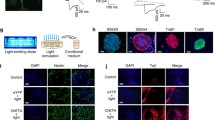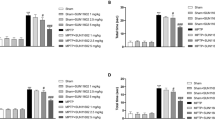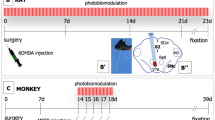Abstract
Our previous research has suggested that lack of Bcl-2-supported axonal growth mechanisms and the presence of glial scarring following injury are major impediments of optic nerve regeneration in postnatal mice. Mice overexpressing Bcl-2 and simultaneously carrying impairment in glial scar formation supported robust optic nerve regeneration in the postnatal stage. To develop a therapeutic strategy for optic nerve damage, the combined effects of chemicals that induce Bcl-2 expression and selectively eliminate mature astrocytes—scar forming cells—were examined in mice. Mood-stabilizer, lithium, has been shown to induce Bcl-2 expression and stimulate axonal outgrowth in retinal ganglion cells in culture and in vivo. Moreover, astrotoxin (alpha-aminoadipate), a glutamate analogue, selectively kills astrocytes while has minimal effects on surrounding neurons. In the present study, we sought to determine whether concurrent applications of lithium and astrotoxin were sufficient to induce optic nerve regeneration in mice. Induction of Bcl-2 expression was detected in the ganglion cell layer (GCL) of mice that received a lithium diet in compared with control-treated group. Moreover, efficient elimination of astrocytes and glial scarring was observed in the optic nerve of mice treated with astrotoxin. Simultaneous application of lithium and astrotoxin, but not any of the drugs alone, induced robust optic nerve regeneration in adult mice. These findings further support that a combinatorial approach of concurrent activation of Bcl-2-supported growth mechanism and suppression of glial scarring is required for successful regeneration of the severed optic nerve in adult mice. They suggest a potential therapeutic strategy for treating optic nerve and CNS damage.





Similar content being viewed by others
References
Yick LW, Wu W, So KF et al (2000) Chondroitinase ABC promotes axonal regeneration of Clarke’s neurons after spinal cord injury. Neuroreport 11:1063–1067
Hunt D, Coffin RS, Anderson PN (2002) The Nogo receptor, its ligands and axonal regeneration in the spinal cord; a review. J Neurocytol 31:93–120
Davies SJ, Fitch MT, Memberg SP et al (1997) Regeneration of adult axons in white matter tracts of the central nervous system. Nature 390:680–683
Davies SJ, Goucher DR, Doller C et al (1999) Robust regeneration of adult sensory axons in degenerating white matter of the adult rat spinal cord. J Neurosci 19:5810–5822
Chau CH, Shum DK, Li H et al (2004) Chondroitinase ABC enhances axonal regrowth through Schwann cell-seeded guidance channels after spinal cord injury. FASEB J 18:194–196
Kim JE, Liu BP, Park JH et al (2004) Nogo-66 receptor prevents raphespinal and rubrospinal axon regeneration and limits functional recovery from spinal cord injury. Neuron 44:439–451
Chen DF, Jhaveri S, Schneider GE (1995) Intrinsic changes in developing retinal neurons result in regenerative failure of their axons. Proc Natl Acad Sci USA 92:7287–7291
Goldberg JL, Klassen MP, Hua Y et al (2002) Amacrine-signaled loss of intrinsic axon growth ability by retinal ganglion cells. Science 296:1860–1864
Chen DF, Schneider GE, Martinou JC et al (1997) Bcl-2 promotes regeneration of severed axons in mammalian CNS. Nature 385:434–439
Chierzi S, Strettoi E, Cenni MC et al (1999) Optic nerve crush: axonal responses in wild-type and bcl-2 transgenic mice. J Neurosci 19:8367–8376
Lodovichi C, Di Cristo G, Cenni MC et al (2001) Bcl-2 overexpression per se does not promote regeneration of neonatal crushed optic fibers. Eur J Neurosci 13:833–838
Inoue T, Hosokawa M, Morigiwa K et al (2002) Bcl-2 overexpression does not enhance in vivo axonal regeneration of retinal ganglion cells after peripheral nerve transplantation in adult mice. J Neurosci 22:4468–4477
Cho KS, Yang L, Lu B et al (2005) Re-establishing the regenerative potential of central nervous system axons in postnatal mice. J Cell Sci 118:863–872
Huang X, Wu DY, Chen G et al (2003) Support of retinal ganglion cell survival and axon regeneration by lithium through a Bcl-2-dependent mechanism. Invest Ophthalmol Vis Sci 44:347–354
Chen RW, Chuang DM (1999) Long term lithium treatment suppresses p53 and Bax expression but increases Bcl-2 expression. A prominent role in neuroprotection against excitotoxicity. J Biol Chem 274:6039–6042
Chen G, Zeng WZ, Yuan PX et al (1999) The mood-stabilizing agents lithium and valproate robustly increase the levels of the neuroprotective protein bcl-2 in the CNS. J Neurochem 72:879–882
Takada M, Hattori T (1986) Fine structural changes in the rat brain after local injections of gliotoxin, alpha-aminoadipic acid. Histol Histopathol 1:271–275
Khurgel M, Koo AC, Ivy GO (1996) Selective ablation of astrocytes by intracerebral injections of alpha-aminoadipate. Glia 16:351–358
McGraw J, Hiebert GW, Steeves JD (2001) Modulating astrogliosis after neurotrauma. J Neurosci Res 63:109–115
Cho KS, Chan PM, So KF et al (1999) Ciliary neurotrophic factor promotes the regrowth capacity but not the survival of intraorbitally axotomized retinal ganglion cells in adult hamsters. Neuroscience 94:623–628
Miyoshi T, Kurimoto T, Fukuda Y (2006) Attempts to restore visual function after optic nerve damage in adult mammals. Adv Exp Med Biol 557:133–147
Benowitz L, Yin Y (2008) Rewiring the injured CNS: lessons from the optic nerve. Exp Neurol 209:389–398
Martinou JC, Dubois-Dauphin M, Staple JK et al (1994) Overexpression of BCL-2 in transgenic mice protects neurons from naturally occurring cell death and experimental ischemia. Neuron 13:1017–1030
Calabrese JR, Kasper S, Johnson G et al (2004) International consensus group on bipolar I depression treatment guidelines. J Clin Psychiatry 65:571–579
Asher RA, Morgenstern DA, Moon LD et al (2001) Chondroitin sulphate proteoglycans: inhibitory components of the glial scar. Prog Brain Res 132:611–619
Jones LL, Yamaguchi Y, Stallcup WB et al (2002) NG2 is a major chondroitin sulfate proteoglycan produced after spinal cord injury and is expressed by macrophages and oligodendrocyte progenitors. J Neurosci 22:2792–2803
Moon LD, Brecknell JE, Franklin RJ et al (2000) Robust regeneration of CNS axons through a track depleted of CNS glia. Exp Neurol 161:49–66
Pilcher HR (2003) Drug research: the ups and downs of lithium. Nature 425:118–120
Hashimoto R, Takei N, Shimazu K et al (2002) Lithium induces brain-derived neurotrophic factor and activates TrkB in rodent cortical neurons: an essential step for neuroprotection against glutamate excitotoxicity. Neuropharmacology 43:1173–1179
Hashimoto R, Senatorov V, Kanai H et al (2003) Lithium stimulates progenitor proliferation in cultured brain neurons. Neuroscience 117:55–61
Ren M, Senatorov VV, Chen RW et al (2003) Postinsult treatment with lithium reduces brain damage and facilitates neurological recovery in a rat ischemia/reperfusion model. Proc Natl Acad Sci USA 100:6210–6215
Jiao J, Huang X, Feit R et al (2005) Bcl-2 signaling Ca2+ to promote the intrinsic regenerative capacity of CNS axons. EMBO J 24:1068–1078
Chalecka-Franaszek E, Chuang DM (1999) Lithium activates the serine/threonine kinase Akt-1 and suppresses glutamate-induced inhibition of Akt-1 activity in neurons. Proc Natl Acad Sci USA 96:8745–8750
Zhan Q, Kontny U, Iglesias M et al (1999) Inhibitory effect of Bcl-2 on p53-mediated transactivation following genotoxic stress. Oncogene 18:297–304
Pugazhenthi S, Nesterova A, Sable C et al (2000) Akt/protein kinase B up-regulates Bcl-2 expression through cAMP-response element-binding protein. J Biol Chem 275:10761–10766
Jope RS (2003) Lithium and GSK-3: one inhibitor, two inhibitory actions, multiple outcomes. Trends Pharmacol Sci 24:441–443
Ozaki N, Chuang DM (1997) Lithium increases transcription factor binding to AP-1 and cyclic AMP-responsive element in cultured neurons and rat brain. J Neurochem 69:2336–2344
Carter DA, Bray GM, Aguayo AJ (1989) Regenerated retinal ganglion cell axons can form well-differentiated synapses in the superior colliculus of adult hamsters. J Neurosci 9:4042–4050
Hankin MH, Lund RD (1990) Induction of target-directed optic axon outgrowth: effect of retinae transplanted to anophthalmic mice. Dev Biol 138:136–146
Acknowledgments
Grant supports: EY017641 from the National Eye Institute; Department of Defense (W81XWH-04-2-0008); Massachusetts Lion’s Eye Research Fund.
Author information
Authors and Affiliations
Corresponding author
Additional information
Special issue article in honor of Dr. Ji-Sheng Han.
Rights and permissions
About this article
Cite this article
Cho, KS., Chen, D.F. Promoting Optic Nerve Regeneration in Adult Mice with Pharmaceutical Approach. Neurochem Res 33, 2126–2133 (2008). https://doi.org/10.1007/s11064-008-9736-3
Received:
Accepted:
Published:
Issue Date:
DOI: https://doi.org/10.1007/s11064-008-9736-3




